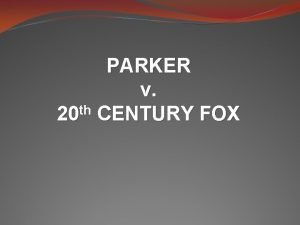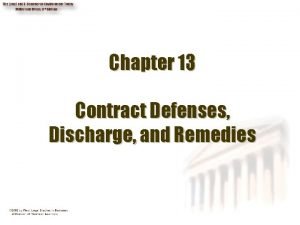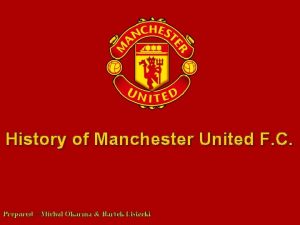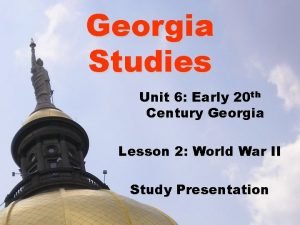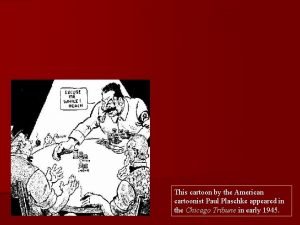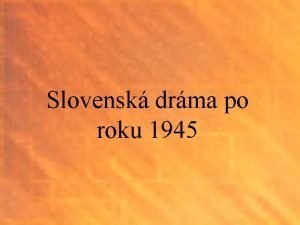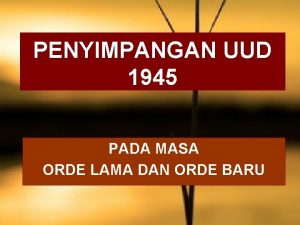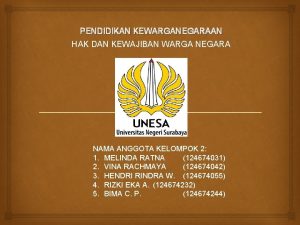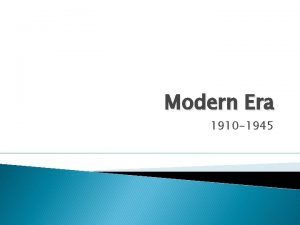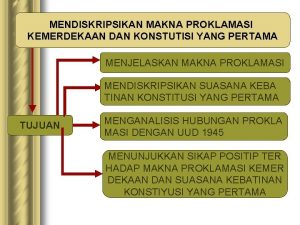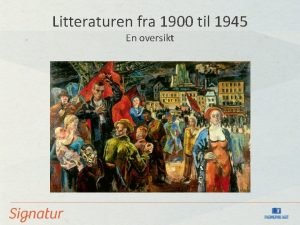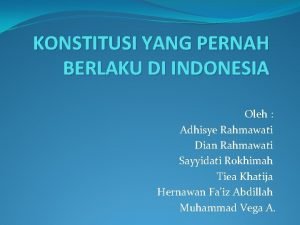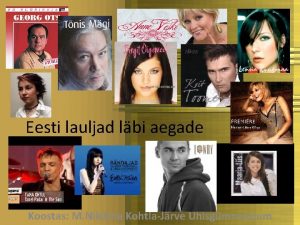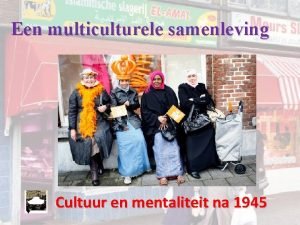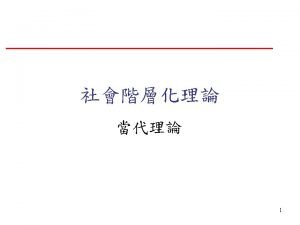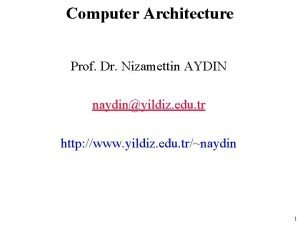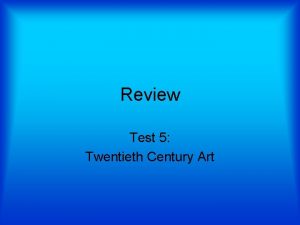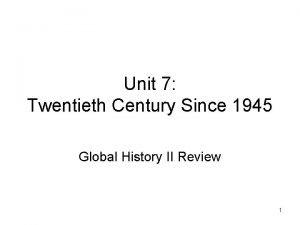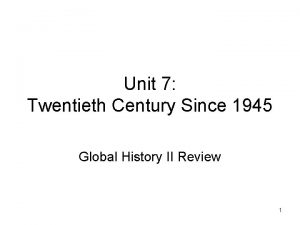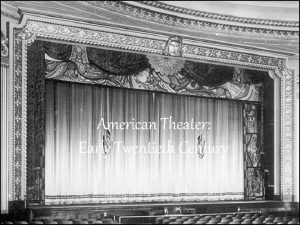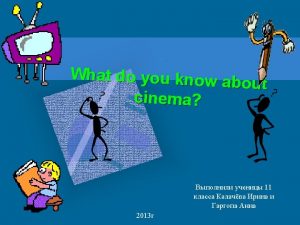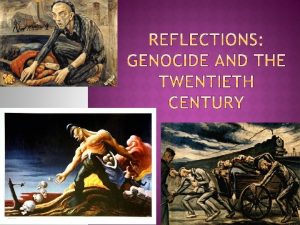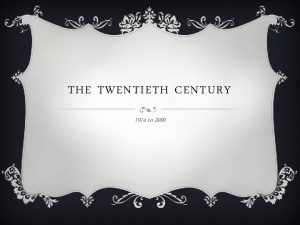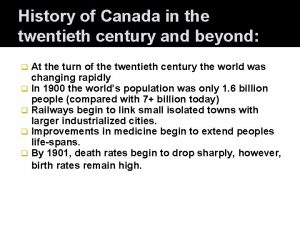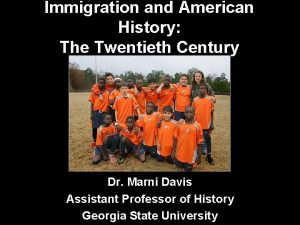Unit 2 Twentieth century history 1945 2000 Area


















- Slides: 18

Unit 2: Twentieth century history 1945– 2000 Area of Study 1: Competing ideologies Outcome 1: Explain the ideological divisions in the post-war period analyse the nature, development and impact of the Cold War on nations and people, in relation to one or more particular conflicts of the period.

Aftermath of World War II United States of America (USA) Global Initiatives Emergence of superpowers Soviet Union (USSR) Yalta Conference Growing tensions Potsdam Conference Establishment of the United Nations Ideology of capitalism Competing Cold War ideologies Churchill’s ‘Iron Curtain Speech’ Ideology of communism

United States The US became incredibly wealthy throughout the war. Aside from Pearl Harbour, America was never invaded and did not have to spend billions on rebuilding or paying debts like other countries involved in the war. Their wealth also increased through industry, with supplying weapons to the Allies throughout the war. The US also demonstrated their strength and power through the technology of the atomic bomb and a large navy and air force.

America’s wealth increase in statistics � American factory production increased by 50% during the war. � By 1945, 50% of the world’s manufactured goods and 33% of the world’s exports came from the US. � At the same time, the US held 67% of the world’s gold reserves. � With 1200 major warships and 2000 heavy bomber aircraft, the US had the strongest navy and aircraft in the world.

Soviet Union: Military Strength The Soviet Union achieved strength in numbers within their army, due to the sheer size of the nations population. The Soviet Union army accomplished a single-handed defeat of the Germans in Eastern Europe and were the first to capture Hitler’s headquarters in Berlin. In World War II, the Soviet Union suffered 27 million military and civilian deaths.

Tensions continue after WW 2 The two superpowers, United States and the Soviet Union, had suppressed their hostility towards each other through a mutual hatred of Hitler. They had joined forces to defeat the Nazi regime from opposite sides; the US from the west and the Soviet Union from the east. However once Nazi Germany and Hitler had been defeated, conflict between to two superpower countries developed due to a number of problems. �Global initiatives �Arguing over Poland at Yalta �Arguing over Germany at Potsdam

Problem 1: Global initiatives U. S president Roosevelt and British Prime Minister Churchill developed three global initiatives for a new world post war: � The United Nations – to deal with maintaining international peace. � The International Monetary fund – to minimise the chance of economic depression � The World Bank – to aid in the reconstruction of destroyed countries

Initiatives – Stalin’s reaction These initiatives were devised to create a more secure global community after a devastating war, not to promote capitalism. However, Soviet President Stalin interpreted these moves as being politically motivated by the capitalist Western Allies in order to wipe out communism. Stalin developed a permanent distrust of the West due to these initiatives

Problem 2: Yalta In February 1945, Churchill, Roosevelt and Stalin met in the Soviet resort town of Yalta. Discussions focused on the punishment for a defeated Germany and the future governance of Poland. All agreed upon the unconditional surrender and joint occupation of Germany and war crime trials for Nazi leaders. But the Big Three disagreed on the other matter at hand, the governance of the largest country in Eastern Europe, Poland.

Yalta – arguing over Poland � Churchill did not want communism to spread and as he did not trust Stalin, he did not want Poland to be controlled by Stalin. � Roosevelt wanted democracy in Poland, but also wanted to remain on good terms with the Soviet Union when the war ended. � Stalin was primarily concerned of security given that Poland had previously been used as a corridor for attack on Russia. Therefore, any new government of Poland must be on good terms with the Soviet Union. He was very reluctant to give up Polish territory controlled by his Red Army.

Governance of Poland This issue of Poland’s self-determination was not resolved as Churchill and Roosevelt feared that Stalin intended to expand communism throughout Europe. Stalin refused to reinstate the democratic government from before the war and had already installed a communist government.

Problem 3: Potsdam Nazi leaders surrendered unconditionally on May 8, 1945 after Hitler’s suicide. After this, Churchill and Stalin met with the new U. S President, Harry Truman, in Potsdam outside of Berlin. Truman’s approach was more aggressive than that of Roosevelt; he wanted to “get tough with the Russians”. Truman’s confidence in arguing was strengthened by the awareness of his military power after the testing of the atomic bomb on Hiroshima and Nagasaki.

Potsdam � The Allied Control Council was set up to oversee the division of Germany into four zones, one for each of the main Allied nations – the US, the Soviet Union, Britain and France. Proceeds from the breakup of the German navy were divided equally. � A War Crimes Tribunal was set up to ensure “swift and sure justice” was brought for Nazi leaders. � Stalin demanded $10 billion from Germany to repair damage to the Soviet Union, but was refused this. Stalin himself then refused Britain’s and the United State’s request for a greater say in Eastern Europe. � Governance in Poland was still disputed.

Task � Create a comparative chart showing the essential features of the Yalta and Potsdam peace conferences; headings could include: dates and venues, key personnel and their expectations, key issues, outcomes

Establishment of the United Nations The United Nations was the new international organisation that replaced the failed League of Nations. It was envisioned and proposed by Roosevelt and Churchill immediately after World War II when the Western world was desperate to end conflict. Draft proposals were created by representatives from the Soviet Union, United States, Britain and China. These proposals were then discussed and debated by 50 nations, which resulted in the United Nations charter in June 1945. On 24 October 1945, the new peacekeeping body officially began.

Competing ideologies Communism was the ideology followed by the Soviet Union. Originally founded by Karl Marx, it said that everything should be owned by the government and then divided up equally among the people who would then all work for it. Not only was the Soviet Union communist, they were totalitarian, meaning all the power was with the rulers. Capitalism was the ideology that the United States followed. It meant that people could own land businesses and compete for themselves. This led to a stark contrast between poor and rich. They were also a democracy, which meant it was the people who had a say by electing rulers.

Cold War � The term ‘Cold War’ is used to describe the relationship between America and the Soviet Union 1945 to 1980. Neither side ever fought the other but they did ‘fight’ for their beliefs using client states who fought for their beliefs on their behalf e. g. South Vietnam was anti. Communist and was supplied by America during the war while North Vietnam was pro-Communist and fought the South (and the Americans) using weapons from communist Russia or communist China. In Afghanistan, the Americans supplied the rebel Afghans after the Soviet Union invaded in 1979 while they never physically involved themselves thus avoiding a direct clash with the Soviet Union.

Iron Curtain details: http: //www. encyclopedia. com/topic/Iron_curtain. aspx Full speech: https: //www. youtube. com/watch? v=l. Mt 7 z. Ca. VOWU Cold War – Crash Course videos https: //www. youtube. com/watch? v=9 C 72 ISMF_D 0 https: //www. youtube. com/watch? v=y 9 Hjv. HZf. CUI
 Parker v twentieth century fox
Parker v twentieth century fox Parker v twentieth century fox
Parker v twentieth century fox Twentieth sunday after trinity
Twentieth sunday after trinity Fc united of manchester wiki
Fc united of manchester wiki Unit 6 early 20th century ga
Unit 6 early 20th century ga Unit 6 review questions
Unit 6 review questions Stalin political cartoon
Stalin political cartoon Slovenska drama po 1945
Slovenska drama po 1945 Penyimpangan uud 1945 orde lama
Penyimpangan uud 1945 orde lama Multipatride adalah
Multipatride adalah 4 pokok pikiran pembukaan uud 1945
4 pokok pikiran pembukaan uud 1945 The modernist period (1910 to 1945)
The modernist period (1910 to 1945) Sidang pertama ppki 18 agustus 1945
Sidang pertama ppki 18 agustus 1945 Litteraturen 1900 til 1945
Litteraturen 1900 til 1945 Sistematika konstitusi ris
Sistematika konstitusi ris Eesti lauljatarid
Eesti lauljatarid Nederland na 1945 cultuur en mentaliteit
Nederland na 1945 cultuur en mentaliteit Davis and moore 1945
Davis and moore 1945 Giga mega tera
Giga mega tera
